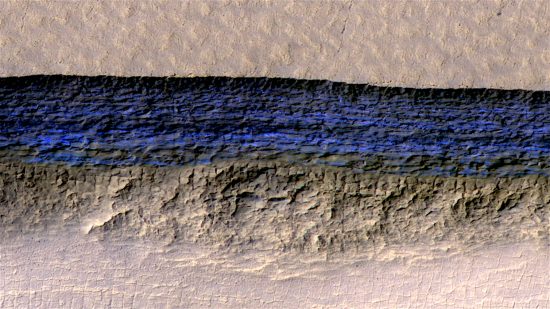
Jan 15, 2019
Does water ice exist on Mars?
“He who cannot put his thoughts on ice should not enter into the heat of dispute.”
— Friedrich Nietzsche
Mars is mysterious. Although it is the most extensively studied celestial body—from the days of Giovanni Schiaparelli to the Curiosity rover wandering its surface—it remains unclear how Mars fits in with ideas about the Solar System’s development and evolution.
Water is considered to be essential for life, since it sustains Earth’s ecology. Imaging systems, such as the High Resolution Imaging Science Experiment (HiRise), for example, are looking for evidence that water exists or, that it once existed, on the surface of Mars. Frozen blocks of ice are also believed to exist in deep shadow, or beneath surface regolith. Layered rock strata suggest to NASA scientists that they see ancient sediments deposited by water and then eroded by wind.
The annual mean temperature of Mars is about minus 50 Celsius, although It is so cold in the northern and southern latitudes that carbon dioxide freezes into a solid blanket of dry ice. Planetary scientists suggest that water is bound up with those icy soils, because the atmosphere is so thin that ice sublimes directly into vapor. Therefore, it is more likely that ice is contained within subsurface Martian glaciers.
On Earth, glaciers are thought to leave forensic evidence of their passing. Varves, moraines, and loess deposits lead geologists to conclude that, at sometime in the past, mountains of ice bulldozed enormous piles of soil and rock ahead of their advancement during the last ice age. Glacial movement is said to sort gravel and sand into distinctive formations.
In 1997, one of the first discoveries made by the Mars Global Surveyor (MGS) was outcrops of layered rock extending for hundreds of kilometers through the Schiaparelli Basin, as well as the floor of Valles Marineris.
Hundreds of craters and giant scarps dominated by faulting and pitting were seen by MGS. As mentioned, drifts of sand at the base of the cliffs, along with light-toned ripples in Schiaparelli Basin are thought to be periglacial landforms. They exhibit polygons, circles, scalloped edges and mounds. On Earth, it is thought that such features arise because ice between soil grains melts and then refreezes in a cycle of expansion and contraction, causing the soils to sort themselves by size and density.
According to a recent press release, the Mars Reconnaissance Orbiter (MRO) “…found eight sites where thick deposits of ice beneath Mars’ surface are exposed in faces of eroding slopes.”
Radar studies found what could be ice covered with dust and rock. However, it is difficult to confirm that the layers seen in radar echoes are icy deposits, and the MARSIS instrument (Mars Advanced Radar for Subsurface and Ionosphere Sounding) does not have sufficient resolution to penetrate more than 20 meters beneath the surface. More detailed examination is necessary.
Previous Picture of the Day articles propose that powerful electric arcs once eroded the Martian surface. Plasma discharge effects left sinuous rilles, flat-floored craters, “railroad track” patterns, craters, intersecting gullies, giant mesas and steep-sided ravines in landscapes dotted with circular uplifts.
If Martian topography was the scene of planetary lightning bolts and not mountains of ice or floods of water, could there be another reason for the detection of ionized hydrogen escaping from beneath the surface? After all, understanding water on Mars is pretty baffling. It is estimated that five-sixths of the “original” water is gone, and that the Martian atmosphere continues to lose hydrogen. Most scientists think that Mars did not have enough carbon dioxide in the past to keep it warm enough to sustain liquid water, so the mysteries of water on Mars are only getting more confusing.
Stephen Smith












